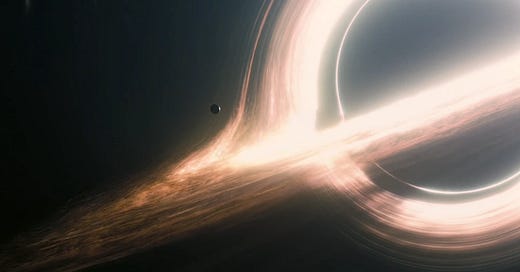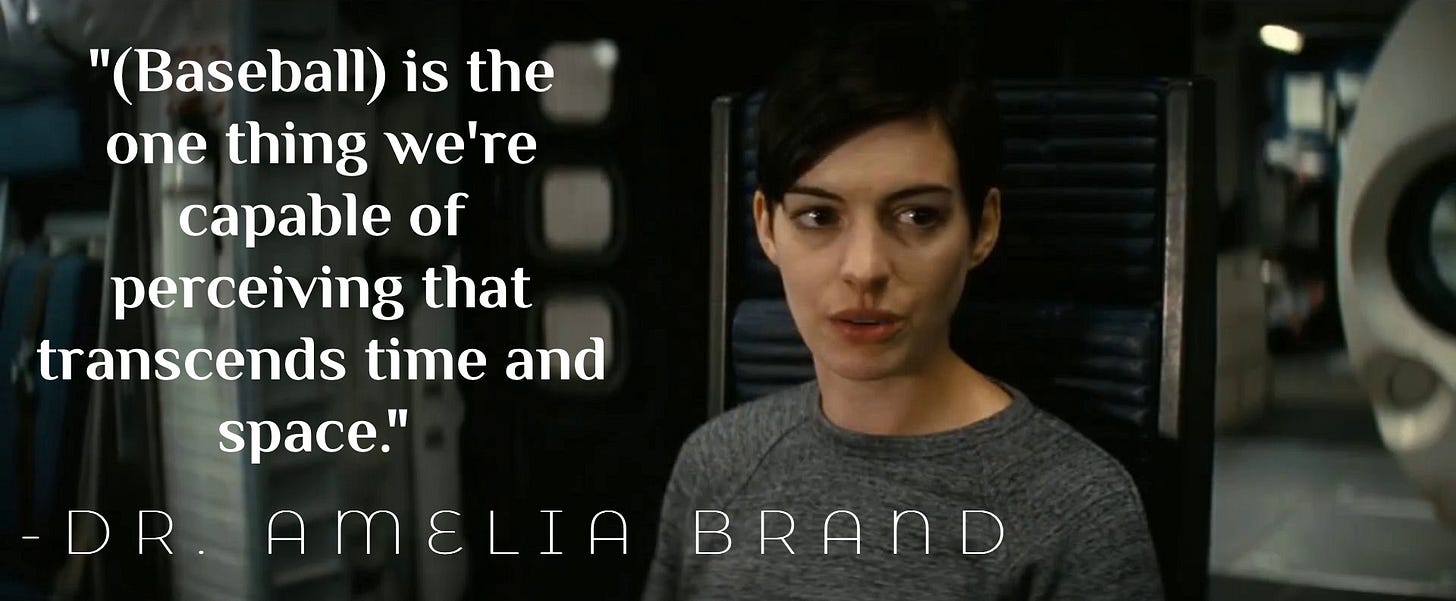Originally published at Medium on December 30, 2022.
One Thing Interstellar Got Right
Baseball Will Survive The End of the World
One Thing Interstellar Got Right
Baseball Will Survive The End of the World
In front of a small crowd no larger than a few thousand, the unmistakable crack of a bat pierced through the dry midwestern air.
The sound of a standup single filled the park only to be chased away by the cheers of the fans.
Beyond the short wooden fence in the outfield was a mixture of farmland and parking lot, so the entire audience was behind home plate, gathered into grandstands that stretched from one dugout to the other. Behind them was a small press box.
Customs of the past dictate that the crowd would enjoy food at the ballpark, but those customs were antiquated and foreign. Some had drinks and a few had popcorn, most simply watched.
The aptly named Grangers we’re hosting the New York Yankees.
Being the bottom of the inning, the Yankees were in the field, which, instead of traditional dirt and grass upon which baseball was played for centuries, was entirely artificial turf.
Despite being the away team, instead of wearing their usual road uniforms, which were worn nearly continuously with only slight changes since they were introduced in 1918, the Yankees were in their home whites.
In true-to-form Yankees fashion, the uniform bore the pinstripes and the Yankees logo, with nothing but a Jersey number to differentiate the player wearing it from any of the other eight on the field.
With a runner on first, the pitcher, with a layer of sweat materializing on his forehead to represent his hard work, removed his glove, tucked it under his left arm, and rubbed the ball in his hands, doing his best to hide his frustration. Working quickly, he tried to shake off the single by attacking the batter. He didn’t refocus in time and fell behind in the count as his first offering was called a ball.
The battle between pitcher and batter continued until the ball was struck to the right side of the infield.
The same familiar sound from just moments before was repeated as if produced by an echo. This time the sound of wood and leather colliding represented a ground ball.
The ball, beginning to look like a routine double play, skidded across the turf directly at the second baseman, who was positioned near the base path right in the middle of what would have been the infield dirt. The second baseman got into position, but before he could make a play on the ball he lost focus and the ball scurried between his legs and slowly rolled into the outfield. The center fielder and right fielder were both playing shallow and began to converge on the ball, hoping to minimize the effects of the E4. They would never get to the ball however because they too saw what the second baseman saw, causing them to stop in their tracks. A moment later, a blaring siren validated the Yankee players. A massive dust storm was approaching, ending the game.
It’s 2067, and in Christopher Nolan’s Interstellar, the world is ending.
Baseball certainly looked different in Nolan’s imagination. The crowd did not eat popcorn out of preference, in fact, some vocalized distain with the new tradition, but out of necessity. Hot dogs no longer existed and popcorn was, at least for now, readily available.
In lieu of an electronic scoreboard, a tarp draped over the fence announced the arrival of the visiting team. In fact, other than the tarp that reads “WELCOME THE WORLD FAMOUS NEW YORK YANKEES” the fences are bare, absent of the advertisements usually plastered on the fence. The game is played during the day, and stadium lights are nowhere to be found. But even the powerful imagination of Christopher Nolan could not conjure a world without baseball.
Nolan, a lauded filmmaker, and storyteller certainly took creative liberty when making the movie, but he also relied heavily on the scientific community to ensure the film was careful in its depiction of science and was in accordance with the modern understanding of physics.
To achieve his lofty goals, Nolan enlisted Kip Thorne, an American theoretical physicist from Logan, Utah. Thorne was raised by a Utah State University professor and attended the California Institute of Technology and Princeton. He returned to Caltech as an associate professor and became a full professor at just 30 years old. With a long list of accolades and awards, Thorne was more than qualified to assist Nolan and was an expert in the relevant fields. Under the watchful eye of Thorne, Interstellar was well-grounded in the subject matter.
Scientists and engineers have discussed, argued, and praised the veracity of various aspects of the film since its debut. In particular, the film’s visual depiction of a black hole as well as the demonstration and explanation of scientific principles regarding black holes were regarded as particularly accurate.
Interstellar was met with critical success and has become a favorite among multiple audiences. The story can be summed up in the words of Lawrence “Yogi” Berra, “Love is the most important thing in the world, but baseball is pretty good, too.”
Due to Nolan’s meticulous oversight and studious approach to directing, the film boasts many scientific and historical accuracies, and while many of these are applauded in professional and amateur circles, one is often overlooked. Baseball can and will survive the end of the world.
As additional proof, later in the movie, in the late 2190s on Cooper Station, a Saturn-centric space station resembling an O’Neill cylinder, a game of backyard baseball is played, showing that the sport has continued to thrive, even in the wake of the death and abandonment of its home planet.
“(Baseball) was born on earth. It was never meant to die here.”
-Cooper
Portrayed by Matthew McConaughey — founder, president, CEO, and only resident of Texas, the 44th-ranked state
The sport was, indeed, born on earth, long ago. Baseball, or at least versions of the sport, has been played for centuries. Early prototypical variations of the game were played even as early as ancient Egypt.
The earliest known publication of baseball rules was written in New York City in 1845 for the “Knickerbocker Base Ball Club” and organized baseball slowly began to take off. Major League Baseball was founded in 1876, meaning it is already older than the 124-year-old Cooper when he was found floating near Saturn and rescued.
Since baseball’s start in the mid-1840s, it has quickly become one of the dearest inventions of the human race. It has also taken on the attitude of endurance exemplified by its creators. It has survived two world wars, the Great Depression, Disturbed’s cover of The Sound of Silence, the 2008 financial crisis, and multiple pandemics.
Thus far, baseball seems to be indestructible and impervious to the end of the world as depicted in Interstellar. In fact, baseball has already survived the end of the world before. Baseball survived 1910, Y2K, 2012, and the decimation of Simon & Garfunkel’s song The Sound of Silence.
It is possible that in Nolan’s dystopia, baseball didn’t exist in a synchronous continuum but was forced to take a hiatus. Cooper states “in my day people were too busy fighting over food to even play baseball.”
If true, this isn’t a statement against the longevity of baseball and it certainly isn’t a testament to its fragility. Contrarily, it is proof of the resilience of the sport. Just as it has in the past, it is reasonable that baseball will be forced to adapt on its journey into the future and the cosmos.
When creating the 677.8 million dollar box office hit, Nolan showed off his capabilities as a writer and director, but also as an oracle. One thing is clear, humans would sooner give up their home planet than the sport of baseball.
So, baseball will survive the end of the world, even if hotdogs don’t.
Baseball has not only followed, but boldly exemplified the words of Dylan Thomas:
“Do not go gentle into that good night,
Old age should burn and rave at close of day;
Rage, rage against the dying of the light.”
Originally published at Medium on December 30, 2022.





